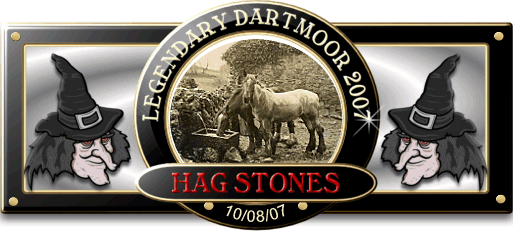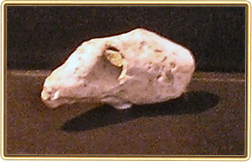
If ever you happen to be around any old Dartmoor farm buildings you may possibly notice a small holed stone or pebble sat on a window ledge. Occasionally if the building has a lock with a key still in it there may well be a similar looking holed stone tied to the end of it. These are known as Hex, or more commonly elsewhere, as Hag Stones and their tradition dates back to the time when witches rode along the hedgerows at night. Amazingly enough, although no farmer today would admit to keeping such a stone for any superstitions reasons they will be hard pushed to part with one. In many cases the actual stone with a hole through it will be flint which means as such a stone is not naturally occurring on Dartmoor it was ‘imported’. In a similar light the hex stone may well be a pebble which again had clearly been brought to the moor, probably after a visit to the seaside. Either way they were physically brought back to serve a special purpose and that was for protection from witches and witchcraft.
At one time there was a genuine fear that a local witch may cast an evil spell, or wisht on ones livestock. It may be that the spell ended up in the cows giving no milk or sour milk, possibly the result might be the hens stopped laying. If horses were on the farm there was a strong belief that witches stole them away at night and ‘hag rode’ them hard across the moor. When they re-appeared the next morning the poor beast would be in such a state that it was useless for any kind of work. Basically there was a whole range of ‘nasties’ that a witch could inflict on farm animals should her wrath be incurred. So to counteract any such witchcraft it was thought that a stone with a naturally weathered hole in it would, when placed in a byre, dairy or stable protect all the animals inside. Hence the reason that today you can still see the remnants of this tradition in some of the old farm buildings on the moor. Below is a photograph of one such stone that comes from an old farm building just outside Chagford. As can be seen this one resembles an animals skull for some strange reason, maybe this form afforded an even greater degree of protection.

I have also heard it said that if one looks through the actual hole of a hex stone then it is possible to see the piskies which normally are invisible to the human eye. When worn around the neck a hex stone acted as an amulet and protected the wearer from the ‘evil eye’. The theory being that anyone who attempted to use the evil eye would have their attention drawn to the stone and therefore be unable to work their black magic. Around the Sheepstor area it was thought that wearing the hex stone would protect against the chances of being piskie-led. If anybody suffered from repeated nightmares the simple remedy was to hang a hex stone on the bedstead, its powers would then stop any visits from the ‘Night Mare’.
“Some the nightmare hath prest,
With that weight upon their brest,
No returns of the breath can passe,
But to us the tale is addle,
We can take of her saddle,
And turn the night mare out to grasse.”
As if all the above was not enough it was often thought that rheumatic pains could be eased by placing a hex stone under the mattress. So all in all a hex stone was a very useful addition to the plethora of amulets often used in and around moorland farms for protection against the black arts. The belief in holed stones predates any historic traditions and probably stretches back into prehistoric times on Dartmoor with the huge stone known as The Tolmen Stone. Numerous superstitions have grow around the stone and its curative powers. Again it is the belief in a naturally weathered holed stone only on this occasion it is much larger and has been ‘holed’ by the river Teign. The similarity between the Tolmen and Hex Stones is that by passing or looking through the hole one is seeing into or being transported to another realm, maybe the hole could be described as a portal between two worlds?
 Legendary Dartmoor The many aspects past and present of Dartmoor
Legendary Dartmoor The many aspects past and present of Dartmoor

Your history and numerous ways in which “hag rocks” were and are still commonly used for has been extremely informative. From my childhood I’ve always been interested in nature, forests, & the simplistic yet iintriquit and hidden beautiful treasures I’d often “happen” upon in my exploration of various environments wherever my feet would lead me. So, many journeys walking in a dried up creek, stream, or river bed I’d often find these mysterious rocks w/holes and some w/unique colorings and fantastic shapes too! Somehow my intuition told me they had to have a lost purpose or had been used by my Indian ancestors 😁 Either way, thank you for your time and energy, as well as the desire to unfold the many layers of humanity’s history!